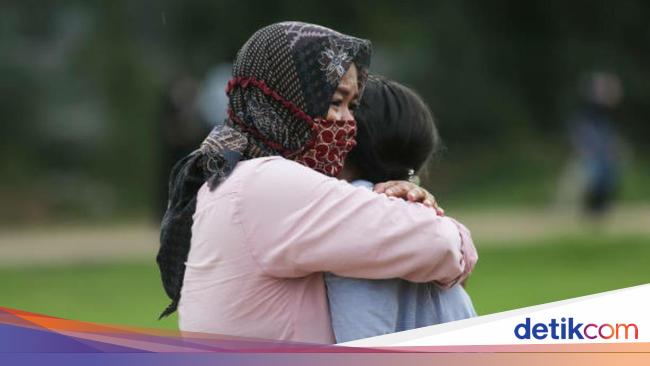Jakarta – Positive child COVID-19 usually experience a number of symptoms such as fever, fatigue, no appetite, to headache. If your child experiences any of the above symptoms, consult a doctor whether the child can self-isolate or should be hospitalized.
Pediatrician Dr. Nina Dwi Putri SpA (K) from FKUI-RSCM said that if children are allowed to self-isolate, there are several steps that parents can take. The step begins with the attitude of parents who remain calm.
Next, calm down and explain why the child must isolate, namely to keep others healthy. Nina said parents may raise children, but if parents are negative, try to avoid exposure to saliva and other body fluids, including by avoiding kissing children.
If the child is independent, parents can find activities that they can do on their own. Also do outdoor activities to change the atmosphere, for example on the terrace or balcony of the house.
Children’s health must be monitored every day. During this period, health protocols (prokes) must still be implemented. Here’s how to monitor a child’s health during self-isolation and the implementation of prokes.
A. Monitoring during child self-isolation
Perform monitoring twice a day by taking notes in the morning and evening. Record the following monitoring points while paying attention to the child’s symptoms such as increased coughing, impaired smell, hearing, vomiting, or diarrhea.
1. Measure the temperature with a thermometer. Normal temperature 36-37.5 Celsius
2. Count the child’s respiratory rate by inhalation per 1 full minute. Normal values for the child’s respiratory rate:
– Infants less than two months: – 2-11 months: – 1-5 years: – > 5 years:
3. Calculate oxygen saturation by oximetry. Normal percentage 95% or more
4. Give children food intake that is high in nutrients and vitamins
5. Monitor children’s activities so that they are in accordance with the procedures and do not pose a risk to health
6. Monitor the child for signs of dehydration, especially if the child has difficulty eating or drinking
7. Communicate monitoring with medical personnel if conditions are outside normal values.
8. Recognize the danger signs when self-isolating children
If you recognize this sign, immediately go to the health facility that handles it COVID-19:
– Child sleeps a lot or decreased consciousness
– Quick breath
– The hollow in the chest, the nose flares up
– Oxygen saturation less than 95%
– Vomiting diarrhea and not entering the intake
– Signs of dehydration
– Seizures
– Continuous fever accompanied by red eyes, rash, and swollen neck
– children with co-morbidities or chronic diseases
B. Prokes at home
Health protocols during self-isolation of COVID-19 positive children are as follows:
1. Determine the COVID-19 positive child patient zone
Separate COVID-19 positive child zones with clean zones at home including bedrooms, bathrooms, and children’s play areas. If a separate zone is not possible, try to keep a distance of at least 1 meter from a sick child.
2. Strive for good ventilation
Ensure good ventilation for air changes during child self-isolation.
3. The child who is positive for COVID-19 uses the bathroom last
Children who are positive for COVID-19 try to eat the shared bathroom last if a separate bathroom is not possible. Give the bathroom usage distance with the next user.
4. Use the mask properly
Children who are positive for COVID-19 aged 2 years and over or who are good at wearing masks are encouraged to wear masks properly.
5. Rest mask
Children who are positive for COVID-19 who are in their own room can get a mask break.
6. Take off the mask while sleeping
Remove the mask when the child is self-isolating when the child is sleeping.
7. Caregivers use disposable protectors
Caregivers who are in the same room as a child who is positive for COVID-19 must always wear a mask and eye protection, disposable gloves, and disposable aprons, or washable outerwear.
8. Caregivers wash their hands after interaction
Caregivers who maintain self-isolation of children must always wash their hands before and after interacting with children.
9. Keep your distance while sleeping
Caregivers as far as possible keep their distance from children who are positive for COVID-19 while sleeping.
10. Dispose of masks and gloves
Caregivers of children who are positive for COVID-19 must dispose of masks and gloves in special plastic containers and dispose of garbage in different bins.
11. Take a shower and change clothes
Parents or caregivers who have to take care of another child who is negative must take a shower and change clothes first after interacting with a child who is positive for COVID-19.
12. Wash children’s clothes and babysitter’s outer clothes separately
Wash COVID-19 positive child’s clothes and caregiver’s outerwear separately with warm water and detergent.
13. Don’t eat leftover food
Avoid eating children’s leftover food or eating with COVID-19 positive children’s cutlery.
14. Caregivers take care of their health and take supplements
Caregivers must maintain health and take supplements while maintaining the child’s self-isolation period
Take care of your health while taking care of your positive child’s self-isolation COVID-19 Yes, detik.com.
Watch Videos”Seeing the Atmosphere of the Nagrak Flats, the Location of Independent Isolation of Covid-19 Patients“
[Gambas:Video 20detik]
(row/row)
– .


